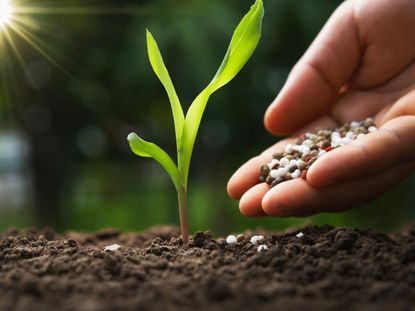Too Much Fertilizer On Plants: Managing Fertilizer Burn In Gardens


We gardeners love our plants-- we spend huge parts of our summers watering, plucking weeds, pruning, and picking bugs off of every denizen of the garden, but when it comes to fertilizing, we often fall into bad habits. Overfertilization in the garden, caused by well-intended but automatic feeding, often results in fertilizer burn of plants. Too much fertilizer on plants is a serious problem, more damaging than too little fertilizer in many cases.
Can Overfertilized Gardens Be Saved?
Gardens that are overfertilized can sometimes be saved, depending on the amount of fertilizer you applied and how quickly you act. Managing fertilizer burn in the garden depends on your speed at recognizing the signs in your plants. Lightly damaged plants may simply wilt or look generally unwell, but plants that are seriously burned may appear to have actually burned-- their leaves will brown and collapse from the edges inward. This is due to the accumulation of fertilizer salts in tissues and a lack of water to flush them out due to root damage. When you realize you've overfertilized, either because of plant symptoms or due to a white, salty crust that forms on the soil's surface, immediately begin flooding the garden. A long, deep watering can move many types of fertilizer from the soil near the surface into deeper layers, where roots aren't currently penetrating. Much like flushing a potted plant that's had too much fertilizer, you're going to need to flood your garden with a volume of water equivalent to the cubic area of the fertilized area. Flushing the garden will take time and a careful eye to ensure that you're not creating standing puddles of water that will drown your already burned plants.
What to Do if You Over Fertilize the Lawn
Lawns need the same kind of fertilizer leaching that gardens do, but it can be much harder to deliver even water to the many grass plants in your yard. If a small area is damaged, but the rest seems okay, focus your efforts on those plants first. Flood the area with a soaker hose or sprinkler, but make sure to remove it before the ground gets boggy. Repeat every few days, until the plants appear to be recovering. There's always a risk of killing plants when you overfertilize; even the most intense leaching efforts could be too little, too late. You can prevent future problems with overfertilization by soil testing before applying fertilizer, using a broadcast spreader to more evenly distribute fertilizer over large areas, and always watering thoroughly immediately after applying an appropriate amount of fertilizer for your plants. Watering helps move fertilizers throughout the soil instead of keeping them close to the surface where delicate plant crowns and tender roots can be damaged.
Gardening tips, videos, info and more delivered right to your inbox!
Sign up for the Gardening Know How newsletter today and receive a free download of our most popular eBook "How to Grow Delicious Tomatoes."

Kristi Waterworth was a regular contributor to Gardening Know How for many years, answering countless queries on plant pests and diseases.